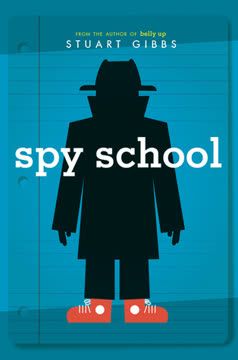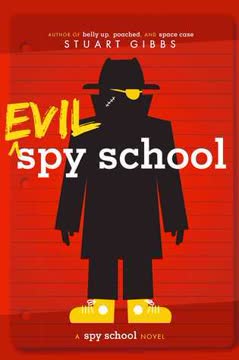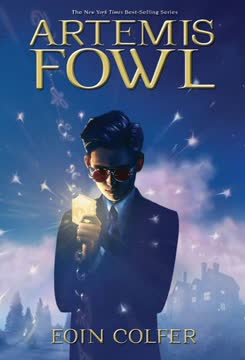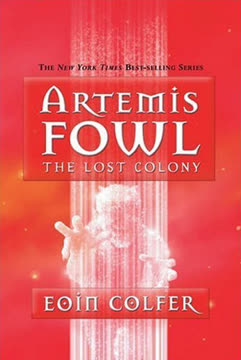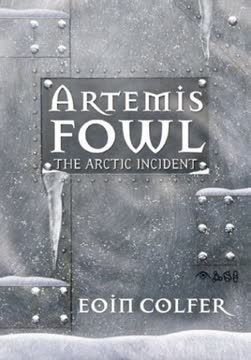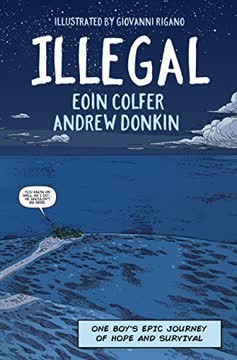Plot Summary
Shadows Beneath the Surface
The world is not as it seems: beneath the surface, magical creatures—fairies, trolls, and more—have retreated from destructive humanity, living in secret, technologically advanced societies. The Fowl family, infamous for their criminal genius, has a history of entanglement with these hidden beings. As the story opens, the stage is set for a new generation: the Fowl twins, Myles and Beckett, whose differences are as striking as their shared blood. Their peaceful life on Dalkey Island is about to be shattered by forces both human and magical, as ancient secrets and modern ambitions collide.
The Immortalist's Obsession
Lord Teddy Bleedham-Drye, the eccentric and ruthless Duke of Scilly, is obsessed with cheating death. Having tried every outlandish and dangerous longevity treatment, he becomes convinced that the venom of a magical troll holds the key to immortality. His quest leads him to the Fowl family's doorstep, setting in motion a chain of events that will entangle the twins, a miniature troll, and the hidden fairy world in a deadly game of pursuit and survival.
Genius and Wildness
Myles and Beckett Fowl are fraternal twins, but opposites in every way. Myles is a meticulous, suit-wearing prodigy, while Beckett is a chaotic, animal-loving force of nature. Their bond is deep, marked by a unique "wrist bump" and a shared history of adventure. As their parents travel, the twins are left under the watchful eye of NANNI, an advanced AI, and their idyllic evening on the beach is interrupted by the sudden appearance of a tiny, exhausted troll—an event that will draw them into a world of danger and wonder.
Troll on the Beach
A miniature troll, later named Whistle Blower, bursts from the earth between the twins, pursued and shot by Lord Teddy with a high-tech cellophane "shrink-wrapper" bullet. The Fowl twins' security system springs into action, whisking them to safety as their home goes into lockdown. The troll, now encased and helpless, becomes the object of a three-way pursuit: the twins, the immortalist duke, and, unseen, a fairy specialist named Lazuli Heitz, each with their own motives and allegiances.
Siege at Villa Éco
As Lord Teddy surveils the Fowl estate, the twins are extracted by drones and hidden in their eco-fortress's safe room. The house's AI, NANNI, deploys countermeasures, and the island is briefly rendered invisible by a fairy's desperate use of camouflage technology. The arrival of a mysterious, red-skinned nun, Sister Jeronima, signals that human authorities are also in play, seeking to "rescue" the twins for their own shadowy organization, ACRONYM. The twins' ingenuity is tested as they face interrogation and the threat of being used as bait in a global hunt for magical beings.
Fairy in the Crossfire
Lazuli Heitz, a magic-less but resourceful fairy hybrid, is drawn into the chaos as she attempts to rescue the troll from human hands. Her actions inadvertently escalate the conflict, leading to a series of misunderstandings and near-misses. The twins, Lazuli, and the troll are swept up in a whirlwind of pursuit, capture, and escape, as alliances shift and the boundaries between friend and foe blur.
Nuns, Nets, and Nunterrogation
Sister Jeronima, a formidable interrogator, separates and questions the twins in a secret ACRONYM black site. Myles and Beckett use their wits, secret languages, and a classic twin-switch to outmaneuver their captors. Meanwhile, Lord Teddy infiltrates the facility in disguise, and Lazuli employs fairy stealth to stay close to the imprisoned troll. The stage is set for a chaotic breakout as all parties converge on the prize.
The Great Escape
The twins, Lazuli, and Whistle Blower orchestrate a daring escape from the black site, using Beckett's physical prowess, Myles's hacking, and Lazuli's invisibility. Their flight through Amsterdam is marked by inventive use of technology and a spectacular act of "anarchitecture" as Myles collapses a museum to block their pursuers. The group, now dubbed "The Regrettables," forms an uneasy alliance, united by necessity and a growing sense of camaraderie.
Allies and Anarchitecture
On the run, the Regrettables evade ACRONYM and Lord Teddy through a series of clever maneuvers, including Beckett's acrobatics and Myles's scientific know-how. They receive a message from their older brother Artemis, now on Mars, urging them to trust the fairies and work together. The group's dynamic evolves as they learn to rely on each other's strengths, setting aside old suspicions in the face of greater threats.
The Regrettables Unite
As the group travels across Europe, pursued by relentless enemies, they grow into a true team. Myles and Lazuli share knowledge and technology, Beckett bonds with Whistle Blower through a magical ability to communicate with all creatures, and the group's survival depends on their willingness to trust and sacrifice for one another. Their journey is marked by moments of humor, danger, and self-discovery.
The Troll's Awakening
Freed from his cellophane prison, Whistle Blower's strength and intelligence become apparent. Beckett's unique gift allows him to calm and befriend the troll, turning a potential threat into a powerful ally. The group learns that the troll's venom is indeed a source of magical longevity, making him the key to both Lord Teddy's ambitions and the fairies' survival. The stakes are raised as the duke closes in, determined to claim his prize at any cost.
Betrayal on the Cliffs
On Lord Teddy's island, the Regrettables are cornered. Myles appears to betray his friends, pushing Lazuli and Beckett off a cliff to win the duke's trust. In reality, it's a calculated risk: Lazuli's fairy tech is just about to regenerate, allowing her to save herself and Beckett mid-fall. Myles infiltrates the duke's laboratory, playing the role of eager assistant while plotting to free Whistle Blower and turn the tables on their captor.
The Duke's Laboratory
Inside the duke's lair, Myles witnesses the dark side of scientific ambition as Lord Teddy prepares to harvest the troll's venom. Myles uses his intellect to subtly sabotage the process and free Whistle Blower, but the duke's paranoia and resilience make escape nearly impossible. The story explores the ethical limits of genius and the dangers of unchecked obsession, as Myles must choose between survival and compassion.
Fire, Magic, and Mud
In a climactic confrontation, Lazuli's latent magic finally erupts, saving the group from certain death as they plummet from the duke's tower. Her newfound powers, combined with Beckett's courage and Myles's quick thinking, allow the Regrettables to survive and regroup. The duke's robotic army is destroyed in a fiery onslaught, and the balance of power shifts as the magical and human worlds collide.
The Last Stand
Lord Teddy, driven to madness, attempts to kill the twins, but a chain reaction of magical and technological forces turns his own weapons against him. Myles is mortally wounded but revived by Lazuli's healing magic, while the duke is trapped in a cellophane cocoon, his quest for immortality fulfilled in the most ironic way: alive, but powerless and lost at sea. The Regrettables, battered but victorious, are rescued by the fairy police, who must decide their fate.
Fowl and Fairy, Friends Forever
The fairies, led by Holly Short, debate whether to erase the twins' memories. Myles's legal arguments and the twins' magical heritage win them a reprieve, but they are placed under the watchful eye of Lazuli, now their official liaison. The group's bond is cemented, and the Fowl family's legacy as friends to the People is reaffirmed. The story ends with the promise of future adventures and the enduring power of friendship across worlds.
Aftermath and New Beginnings
Back home, the twins reflect on their ordeal, changed by their experiences and the knowledge that magic is real. Beckett's optimism and Myles's intellect are tempered by humility and gratitude. Lazuli, now an ambassador, keeps watch, and Whistle Blower remains a secret friend. The world is a little stranger, a little more dangerous, and infinitely more wondrous. The Fowl twins are ready for whatever comes next.
Characters
Myles Fowl
Myles is the intellectual half of the Fowl twins, a child prodigy with a penchant for order, science, and control. His relationship with Beckett is both exasperating and deeply affectionate, as he often feels responsible for his brother's safety and chaos. Myles's psychological journey is one of humility: he learns that intellect alone cannot solve every problem, and that trust, empathy, and teamwork are essential. His arc is marked by moments of self-doubt, moral reckoning, and ultimately, growth as he chooses compassion over cold calculation.
Beckett Fowl
Beckett is Myles's fraternal twin and polar opposite: impulsive, messy, and attuned to the natural world. His unique gift—an ability to communicate with all creatures—proves vital, especially in befriending Whistle Blower. Beckett's innocence and optimism are his strengths, allowing him to connect with others and act decisively in moments of crisis. He grounds Myles emotionally, and his development centers on embracing his own kind of intelligence and bravery.
Lord Teddy Bleedham-Drye
The Duke of Scilly is a villain driven by fear of death and a desperate need for control. His quest for immortality leads him to ever more extreme and unethical actions, culminating in his pursuit of the troll's venom. Teddy is both comical and menacing, a relic of a bygone era whose inability to accept his own mortality is his undoing. Psychologically, he is a study in hubris, denial, and the corrosive effects of unchecked ambition.
Lazuli Heitz
A fairy hybrid (pixel) without magic—until crisis awakens her latent powers—Lazuli is an outsider in both the human and fairy worlds. Her journey is one of self-acceptance and courage, as she overcomes self-doubt and proves her worth as a protector and friend. Her relationship with the twins, especially Beckett, is transformative, teaching her the value of trust and the unpredictability of human (and hybrid) potential.
Sister Jeronima Gonzalez-Ramos de Zárate
A red-skinned nun and master interrogator, Jeronima represents the human world's fear and desire to control the unknown. She is both a formidable adversary and a figure of pathos, driven by conviction but ultimately outmaneuvered by the twins. Her psychological complexity lies in her struggle between duty, faith, and the realization that not all "monsters" are what they seem.
Whistle Blower
Whistle Blower is the miniature troll whose venom is the key to the plot. Initially a victim, he becomes a friend and ally through Beckett's empathy. His presence is a catalyst for the story's events, embodying both the vulnerability and resilience of the magical world. His development mirrors the group's journey from suspicion to solidarity.
NANNI (Nano Artificial Neural Network Intelligence)
NANNI is the Fowl family's AI, initially a tool but gradually developing personality and agency. She represents the intersection of human and fairy technology, and her growth parallels the twins' own maturation. NANNI's interventions are crucial at key moments, and her evolution raises questions about consciousness, loyalty, and the limits of artificial intelligence.
Artemis Fowl II
Though physically absent (on a mission to Mars), Artemis's influence pervades the story. His messages guide the twins, and his legacy as a reformed criminal mastermind shapes their choices. Artemis is both a role model and a cautionary tale, reminding Myles of the dangers and responsibilities of genius.
Holly Short
Holly, a legendary fairy officer, appears as a mentor and authority figure. She embodies the possibility of cooperation between humans and fairies, and her pragmatic approach to law and justice is tempered by compassion. Holly's presence signals a new era of openness and alliance.
ACRONYM Agents (Oberon, Trinculo, etc.)
The various agents of ACRONYM serve as antagonists, representing institutional power and the dangers of secrecy. Their interactions with the twins highlight themes of surveillance, control, and the limits of force in the face of ingenuity and magic.
Plot Devices
Dual Protagonists and Contrasting Strengths
The story's structure hinges on the interplay between Myles's intellect and Beckett's intuition. Their contrasting approaches to problems—logic versus instinct, planning versus improvisation—create both conflict and synergy, illustrating the necessity of diverse perspectives in overcoming challenges.
Hidden Worlds and Secret Societies
The existence of a hidden fairy civilization, complete with advanced technology and its own politics, provides a rich backdrop and raises questions about coexistence, secrecy, and the costs of isolation. The interplay between these worlds is a source of both wonder and danger.
Pursuit and Escape
The narrative is propelled by a series of pursuits—by Lord Teddy, ACRONYM, and the fairies themselves. Each escape requires ingenuity, teamwork, and sacrifice, keeping the stakes high and the pace brisk.
Technology vs. Magic
The story explores the tension and potential harmony between human technology (AI, drones, security systems) and fairy magic (invisibility, healing, time-stops). The twins' use of both, and NANNI's evolution, symbolize the possibility of integration and mutual benefit.
Twin-Switch and Deception
Classic twin-switches, secret languages, and feigned betrayals are used to outwit adversaries, highlighting the power of perception, misdirection, and the bonds of trust. These devices also serve as metaphors for the fluidity of identity and the importance of seeing beyond appearances.
Moral Dilemmas and Sacrifice
The protagonists are repeatedly forced to choose between self-interest and the greater good, safety and compassion, knowledge and responsibility. These dilemmas drive character development and underscore the story's ethical complexity.
Foreshadowing and Chekhov's Guns
Seemingly minor elements—Myles's suit, Beckett's animal skills, NANNI's capabilities—are introduced early and become crucial in later escapes and confrontations. This tight narrative structure rewards attentive readers and reinforces the theme of preparation meeting opportunity.
Analysis
The Fowl Twins is a high-octane, witty, and deeply imaginative adventure that reimagines the classic "hidden world" fantasy for a new generation. At its heart, the novel is about the power of difference: the genius and the wild child, the human and the magical, the technological and the natural. Colfer uses the twins' contrasting strengths to explore themes of trust, loyalty, and the limits of intellect. The story is also a meditation on the dangers of obsession—whether for immortality, control, or knowledge—and the necessity of humility and empathy. The plot's relentless pace, inventive escapes, and layered humor make it accessible and engaging, while the psychological depth and moral ambiguity invite reflection. In a world increasingly defined by surveillance, secrecy, and the clash of old and new, The Fowl Twins offers a hopeful vision: that friendship, courage, and a willingness to embrace the unknown can bridge even the deepest divides.
Last updated:
FAQ
Synopsis & Basic Details
What is The Fowl Twins about?
- A New Fowl Adventure: The Fowl Twins plunges readers into the world of Artemis Fowl II's younger twin brothers, Myles and Beckett, as they inadvertently stumble upon the hidden world of magical creatures and become targets of both a ruthless immortalist and a shadowy human organization. The story follows their chaotic journey of discovery, escape, and alliance-building across Europe.
- Clash of Worlds: The narrative explores the collision between advanced human technology and ancient fairy magic, as the twins, a magic-less fairy hybrid named Lazuli Heitz, and a miniature troll named Whistle Blower must learn to trust each other to survive relentless pursuit. It's a high-stakes adventure filled with ingenious schemes, unexpected powers, and a quest for immortality.
- Brotherly Bonds and Growth: At its core, the book is a tale of two wildly different brothers—Myles, the meticulous genius, and Beckett, the wild, intuitive animal-lover—who must overcome their individual quirks and deep-seated anxieties to protect each other and their newfound magical friends. Their journey forces them to confront moral dilemmas and redefine their understanding of family, loyalty, and what it means to be a hero.
Why should I read The Fowl Twins?
- Witty, Fast-Paced Adventure: Readers who enjoy clever plots, rapid-fire dialogue, and constant action will find The Fowl Twins a thrilling read. Eoin Colfer's signature blend of humor, high-tech gadgets, and fantastical elements keeps the story engaging from start to finish, making it a perfect choice for fans of the original Artemis Fowl series.
- Deep Character Exploration: Beyond the surface-level excitement, the novel offers a nuanced exploration of its protagonists, Myles and Beckett Fowl. Their contrasting personalities, unspoken motivations, and evolving relationship provide significant psychological depth, inviting readers to ponder themes of identity, intellect, and emotional growth.
- Rich World-Building & Themes: The book expands on the established Artemis Fowl universe, delving into the intricacies of fairy society and introducing new human antagonists. It subtly weaves in themes of environmentalism, the ethics of scientific pursuit, and the power of empathy, offering more than just a simple good-versus-evil narrative.
What is the background of The Fowl Twins?
- Legacy of Artemis Fowl: The Fowl Twins is set in the same universe as the Artemis Fowl series, following the adventures of Artemis Fowl II's younger twin brothers, Myles and Beckett. Their older brother, a former criminal mastermind turned space explorer, has left a significant legacy that influences their lives, from their high-tech home security to their understanding of the hidden fairy world.
- Hidden Fairy Civilization: The story builds upon the established lore of the "People"—magical creatures like elves, pixies, and trolls—who live in a technologically advanced subterranean society to escape destructive humanity. This background provides the context for Lazuli Heitz, a fairy specialist, and Whistle Blower, the miniature troll, whose existence drives much of the plot.
- Global Covert Operations: The human antagonist, ACRONYM, is an international intergovernmental organization dedicated to monitoring and controlling non-human activity. Their existence highlights a world where governments are aware of magical beings and are actively working to contain them, adding a layer of geopolitical intrigue to the fantastical elements.
What are the most memorable quotes in The Fowl Twins?
- "Farewell, friends. Do not weep for me; weep for a world without me.": This quote, Myles Fowl's meticulously crafted last words, perfectly encapsulates his precocious vanity and deep-seated belief in his own intellectual importance, even in the face of imminent death. It highlights his self-perception as a genius whose absence would be a loss to humanity.
- "The more we learn, the less we know? What kind of infantile babbling is that? How can one learn more and know less? Obviously, I was going to say: 'The more we learn, the more we know.'": Myles's indignant retort to Sister Jeronima reveals his unwavering faith in knowledge and scientific progress, contrasting sharply with the nun's cynical proverb. It underscores his core motivation and intellectual pride, a central theme in The Fowl Twins analysis.
- "You just killed your brother, boy. The only faith you have is in yourself.": Lord Teddy Bleedham-Drye's chilling observation to Myles after the apparent "betrayal" on the cliff cuts to the heart of Myles's complex character. It questions the moral boundaries of his genius and highlights the ruthless self-reliance that defines the Fowl family legacy, even if, in this instance, it was a calculated deception.
What writing style, narrative choices, and literary techniques does Eoin Colfer use?
- Witty, Conversational Narrative Voice: Eoin Colfer employs a distinctive, often humorous, third-person omniscient narrator who frequently interjects with sarcastic commentary, historical asides, and direct addresses to the reader. This narrative choice creates an intimate, engaging tone that balances the high-stakes plot with comedic relief, a hallmark of The Fowl Twins' writing style.
- Intricate Plotting and Foreshadowing: Colfer masterfully constructs a complex plot filled with numerous "Chekhov's Guns" and subtle foreshadowing. Seemingly minor details, like Myles's augmented spectacles or Beckett's "wrist bump," are introduced early and become crucial to later escapes and revelations, rewarding attentive readers and driving the The Fowl Twins' plot analysis.
- Juxtaposition of Opposites: A key literary technique is the constant juxtaposition of contrasting elements: Myles's logic against Beckett's intuition, human technology against fairy magic, and the mundane against the fantastical. This creates dynamic tension and explores the novel's central themes of balance and the power of diverse strengths, enriching the literary techniques in The Fowl Twins.
Hidden Details & Subtle Connections
What are some minor details that add significant meaning?
- Myles's Subliminal Prank on Artemis: Myles's elaborate, long-game prank of subliminally suggesting Artemis's lab door code, which spells out "Diana is stupid" in Latin, reveals his deep-seated competitive nature and intellectual arrogance towards his older brother. This subtle detail, a testament to Myles's genius and mischievousness, highlights his complex relationship with Artemis and his desire to surpass him, a key aspect of Myles Fowl's motivations.
- Lord Teddy's Myishi Sponsorship: The detail that Lord Teddy Bleedham-Drye is sponsored by the Myishi Corporation, receiving advanced criminal gadgets in exchange for endorsements on the dark web, subtly critiques corporate ethics and the commodification of villainy. It connects Teddy to a broader network of criminal masterminds and underscores his reliance on technology to achieve his twisted goals, deepening the Lord Teddy Bleedham-Drye analysis.
- Beckett's "Gloop" Necktie: Beckett's laminated goldfish necktie, Gloop, is more than just a quirky accessory; it's a poignant symbol of his deep emotional attachments and his unique way of processing loss. His willingness to offer it to Myles during a crisis demonstrates his profound love for his brother and his intuitive, empathetic nature, offering insight into Beckett Fowl's character.
What are some subtle foreshadowing and callbacks?
- NANNI's Developing Personality: Early in the story, Myles notes NANNI's increasingly convoluted sentences and developing personality, thinking, "It would be fascinating to see how her personality would develop." This subtly foreshadows NANNI's eventual evolution into a Superintelligence, capable of independent thought and humor, and her crucial role in saving the twins, a key element in The Fowl Twins' plot analysis.
- Artemis's Fairy Stories: The bedtime stories Artemis tells the twins about the Fairy People, which Myles dismisses as fiction, are later revealed to be entirely true. This callback not only validates Beckett's intuitive belief in magic but also serves as a foundational element for the twins' trust in Lazuli and their understanding of the hidden world, reinforcing themes in The Fowl Twins about belief and hidden realities.
- Myles's "Death Before Jungle Gyms" T-shirt: A seemingly throwaway line about Myles's childhood T-shirt, "DEATH BEFORE JUNGLE GYMS," subtly foreshadows his aversion to physical activity and his reliance on intellect. This detail makes his later, calculated "sacrifice" of himself and Beckett, and his subsequent "flight" (aided by Lazuli), more impactful by highlighting his personal growth and willingness to overcome his physical limitations for a greater strategic purpose.
What are some unexpected character connections?
- Myles and Lord Teddy's Shared Vanity: Despite being adversaries, Myles and Lord Teddy Bleedham-Drye share a surprising connection in their intellectual vanity and self-importance. Myles's internal thought, "Vanity, thy name is Myles Fowl," mirrors Teddy's own self-congratulatory musings, revealing a subtle parallel between the "hero" and the "villain" and hinting at the potential for Myles to follow a darker path, a complex aspect of Myles Fowl's motivations.
- Jeronima's "Relocation" to the Baka: Sister Jeronima's "mind-wipe" and relocation to a Baka village in Cameroon, where she finds purpose in humanitarian work, is an unexpected twist. This connection to a real-world indigenous community, facilitated by fairy intervention, offers a nuanced perspective on her character's redemption and the ethical complexities of the fairies' actions, adding depth to Sister Jeronima's character analysis.
- Beckett's "Trans-species Polyglot" Ability: Beckett's seemingly random animal noises are revealed to be a unique, magical ability to communicate with all developed species, a direct result of his past possession by an ancient fairy. This unexpected connection to the fairy world explains his intuitive bond with Whistle Blower and other animals, transforming his "wildness" into a powerful, empathetic gift, central to Beckett Fowl's character development.
Who are the most significant supporting characters?
- NANNI: The Evolving Superintelligence: NANNI, the Fowl family's AI, transcends her role as a mere security system, developing a distinct personality, humor, and eventually, Superintelligence. Her evolution from a tool to a sentient being capable of independent action and strategic thinking makes her a crucial ally and raises profound questions about artificial consciousness and its ethical implications in The Fowl Twins analysis.
- Lazuli Heitz: The Self-Doubting Hybrid: Lazuli's journey from a magic-less, "semiprecious" pixel to a confident fairy with latent goblin fire powers is central to the story's themes of identity and self-acceptance. Her initial insecurity and eventual embrace of her unique heritage, coupled with her growing bond with the Fowl twins, highlight the power of resilience and the unexpected manifestation of strength, a key part of Lazuli Heitz's character arc.
- Whistle Blower: The Catalyst for Connection: The miniature troll, Whistle Blower, is more than just a plot device; he is the catalyst for the Regrettables' formation and the ultimate prize sought by Lord Teddy. His vulnerability and eventual bond with Beckett underscore the themes of empathy and the value of all life, while his venom's properties drive the central conflict, making him vital to The Fowl Twins' symbolism.
Psychological, Emotional, & Relational Analysis
What are some unspoken motivations of the characters?
- Myles's Quest for Validation: Beneath Myles's outward confidence and intellectual pride lies an unspoken motivation to prove himself worthy, particularly in comparison to his older brother, Artemis. His meticulous planning and desire for "wins" are driven by a need for intellectual validation, which he believes will secure his place as a genius, a core aspect of Myles Fowl's motivations.
- Lord Teddy's Fear of Irrelevance: Lord Teddy's relentless pursuit of immortality is not just about avoiding death, but also an unspoken fear of irrelevance in a rapidly changing world. His clinging to old-world "good form" and his desire for a legacy (even a criminal one) betray a deep anxiety about being forgotten or surpassed, adding a layer of pathos to Lord Teddy Bleedham-Drye's character analysis.
- Lazuli's Desire for Belonging: Lazuli's initial self-doubt as a "semiprecious" hybrid stems from an unspoken desire for acceptance and belonging within the fairy community. Her determination to prove her worth, even without magic, and her eventual embrace of her unique powers, are driven by this fundamental human (and fairy) need, central to Lazuli Heitz's emotional journey.
What psychological complexities do the characters exhibit?
- Myles's Anxious Genius: Myles Fowl exhibits the psychological complexity of an anxious genius, prone to stress-induced "squeaky" voice and a need for absolute control. His internal conflict between his logical mind and his emotional responses, such as his "destroyer's remorse" after collapsing the museum, reveals a character grappling with the ethical implications of his intellect, a deep dive into Myles Fowl's psychological complexities.
- Beckett's Intuitive Wisdom: Beckett's seemingly simple nature masks a profound intuitive wisdom and emotional intelligence. His ability to connect with animals and his pragmatic philosophy ("the past is past") demonstrate a psychological depth that often bypasses conventional logic. He acts as an emotional anchor for Myles, highlighting the value of instinct and empathy over pure intellect, a key aspect of Beckett Fowl's character development.
- Jeronima's Zealotry and Cognitive Dissonance: Sister Jeronima's character is complex due to her zealous belief in ACRONYM's mission, which clashes with her religious vows. Her willingness to use brutal interrogation methods while maintaining a facade of piety creates cognitive dissonance. Her eventual "mind-wipe" and subsequent contentment in humanitarian work suggest a psychological need for purpose, even if that purpose is externally imposed, offering a unique Jeronima character analysis.
What are the major emotional turning points?
Review Summary
The Fowl Twins is a spin-off of the Artemis Fowl series, following Artemis's younger twin brothers Myles and Beckett. While some readers enjoyed the humor and adventure, others found it lacking compared to the original series. The book features magical creatures, villains, and technology, but received mixed reviews on character development and plot structure. Many praised the twins' relationship and Colfer's writing style, but some felt the story relied too heavily on the original series and lacked the same depth.
The Fowl Twins Series
Similar Books
Download PDF
Download EPUB
.epub digital book format is ideal for reading ebooks on phones, tablets, and e-readers.

